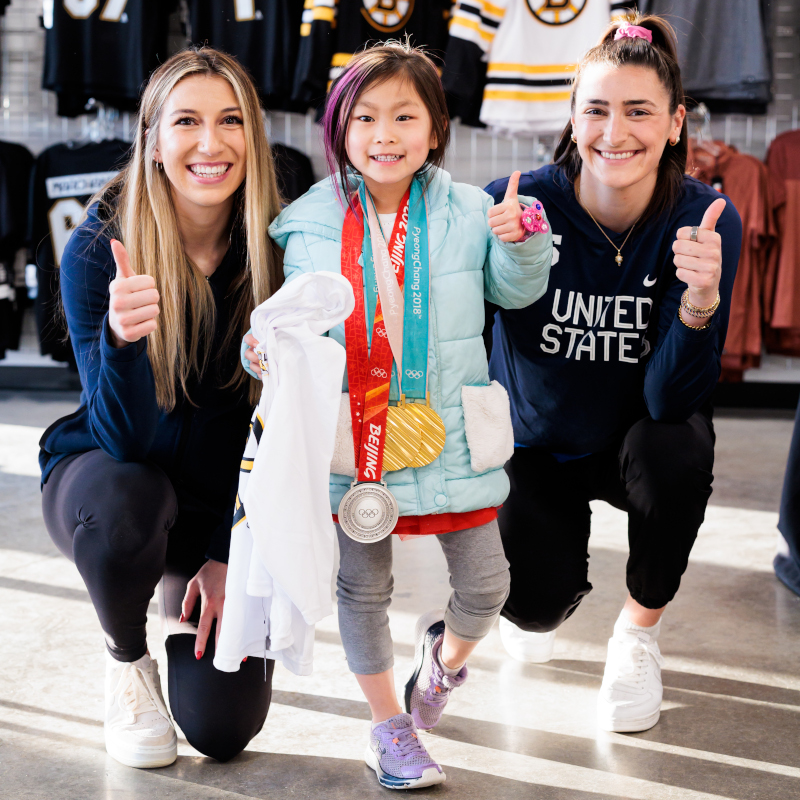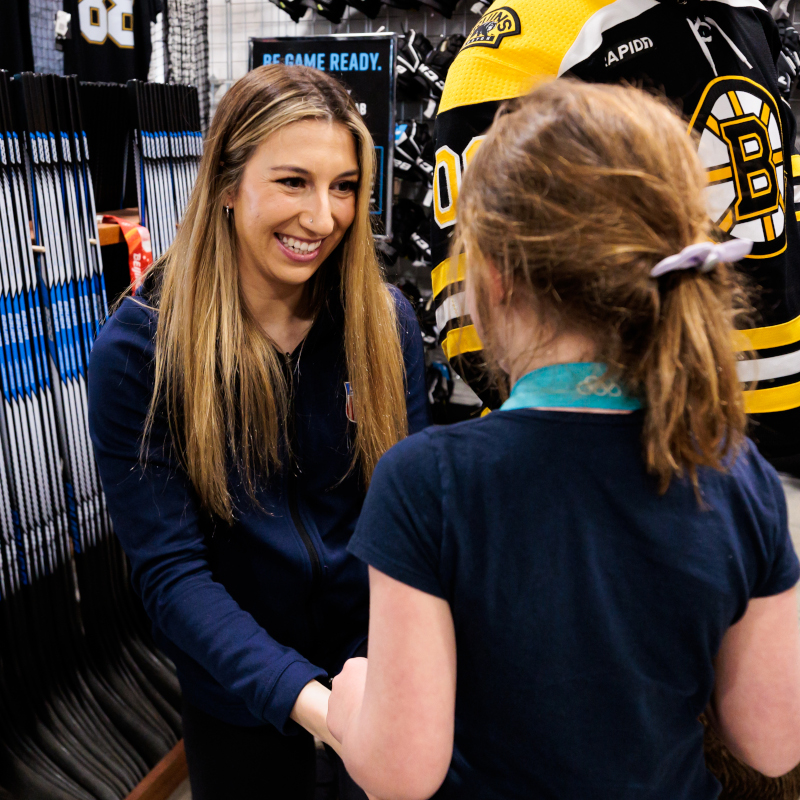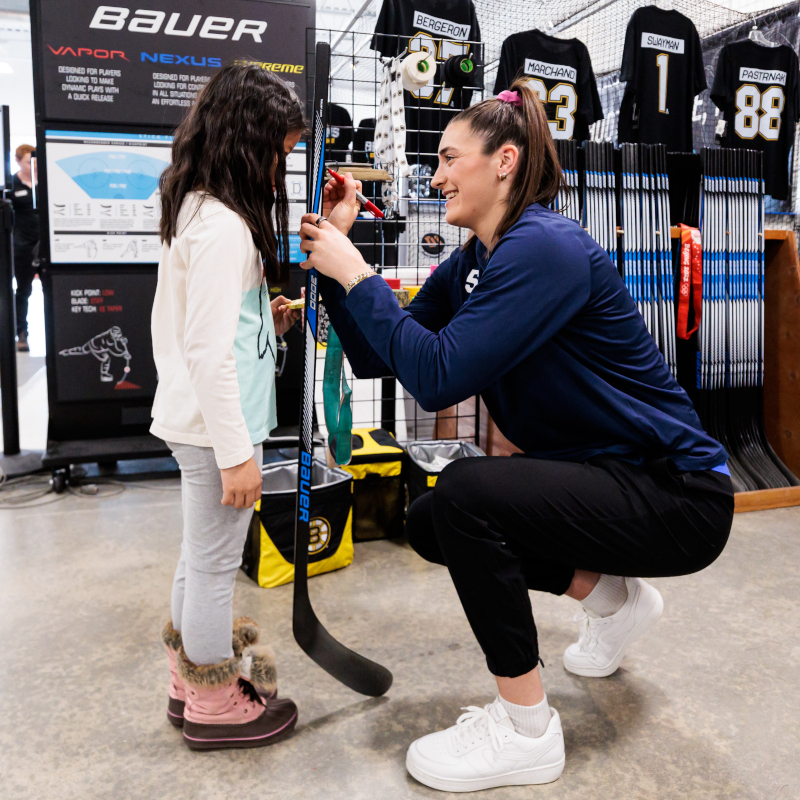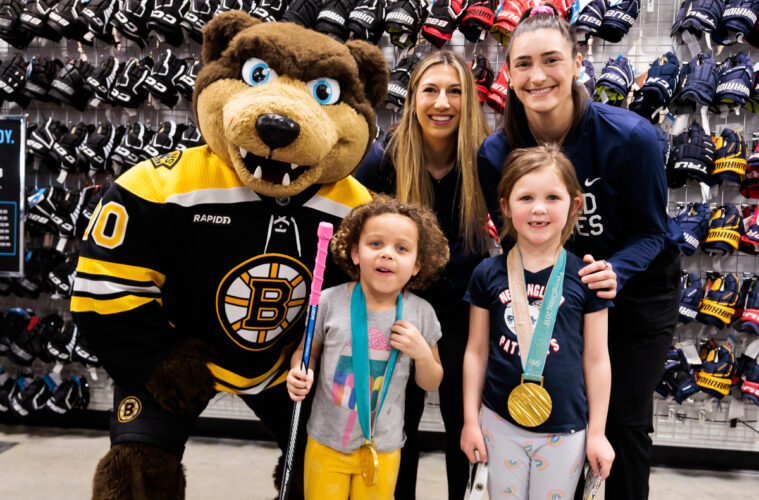On the afternoon of Wednesday, March 8, dozens of little girls and their families cycled through Pure Hockey in Danvers trying on hockey equipment—tiny helmets, tiny shoulder pads, and short sticks to match. After the fittings, two members of the Women’s National Hockey Team, Kali Flanagan and Megan Keller, greeted the girls, taking photos, letting them try on their Olympic gold medals, and picking out colorful tape for their hockey sticks.
The girls, ages five through ten, are participating in the Bruins’ Learn to Play hockey program, a four-week program that gets young kids onto the ice for a low cost, often for the first time.
Presented by hockey equipment retailer Pure Hockey, the program costs $180 and includes four weeks of on-ice instruction and a full set of hockey gear, which the kids get to keep, valued at around $550.

The program helps to break down barriers to the sport, giving girls and their families the “opportunity to get to the rink at a low cost in gear that fits them, and that gives them a great first time experience,” says Mike Dargin, director of youth hockey and fan development for the Bruins. “And if they have a good first experience then they’ll keep playing.”
On March 8, the Bruins and Pure Hockey were focused on giving the girls a positive fitting experience, trying on equipment that would then be mailed to their homes.
The program will get almost 800 girls into gear and onto the ice this spring. Thirteen rinks around the region participate, and each rink hosts sixty girls. North Shore local rinks include Saugus’s Hockeytown USA, Winthrop’s Larsen Rink, and Andover’s Phillips Academy Ice Rink.
The Girls Learn to Play program gives kids four hockey instruction sessions—once a week for four weeks. But the arenas, Dargin says, aim to get kids coming back once the ice is broken, so to speak. “You get there for four weeks, but we want to make sure they have a retention and transition plan to keep them coming back to the rink,” says Dargin.
In fact, over 80% of the kids who do this program continue playing hockey, says Dargin, “because of the positive first time experience they got here.”
Meeting hockey role models
Megan Keller remembers the first time she started dreaming of playing hockey professionally, when she saw the US women’s Olympic team on TV. Now a Women’s National Hockey Team player herself, she’s won two Olympic medals—goal in 2018 and silver in 2022.
“It’s a sport that’s given me so much and it’s important to make it accessible for everybody,” says Keller. “It’s exciting to see all these young girls out here today.”
Both Keller and Kali Flanagan grew up playing hockey with boys. Flanagan, a 2018 Olympic gold medalist, member of the Boston Pride, and Burlington native, emphasizes the importance of getting more girls interested in the sport via visibility.
“I think [visibility] is the biggest thing right now,” says Flanagan. “It’s so important for little girls to see girls playing hockey on TV, and in rinks, and on social media,” she continues. “We always say that if you can see it, you can be it.”


Flanagan herself was introduced to the sport by her dad, who played hockey at Rensselaer Polytechnic Institute, trying on all his hockey equipment down in the basement one day. Keller was introduced by her older brother—”I wanted to do everything he did,” she laughs.
While Keller says she had fun playing with the boys, it was the lifelong friendships she’s made in the girls locker room as she’s grown up that mean the most to her. “Building those friendships and relationships is one of the best parts of team sports and ice hockey in general,” says Keller.
While the spring Learn to Play program is open to girls only, the Bruins run another program in the fall that’s coed. All NHL teams host Learn to Play, but the Bruins’ is the biggest program and involves the most girls. Year round, they get around 4,000 kids involved in hockey, 1,500 of whom are girls.
This year marks the fifth annual girls program, and the tenth coed one starts in the fall. Dargin encourages families interested in the fall program to check the website for more information in August.
“Growing the game is so important to us,” says Flangan. “If girls see other girls [playing hockey], they have role models, and then they can think ‘you know, maybe I can do that one day.’”

